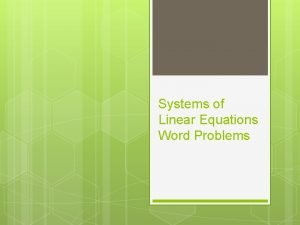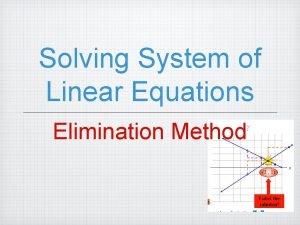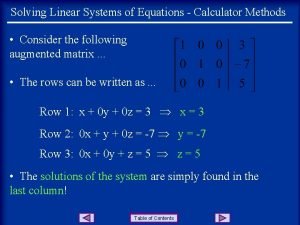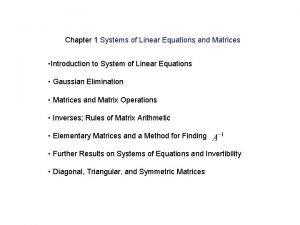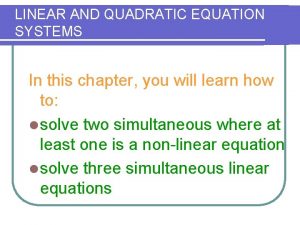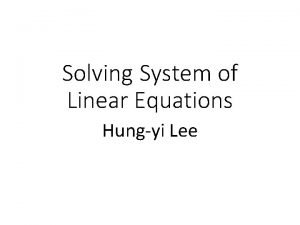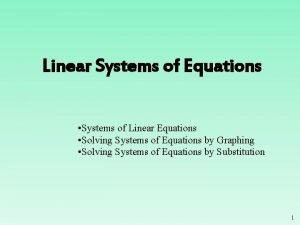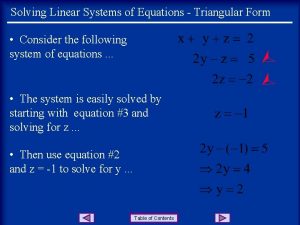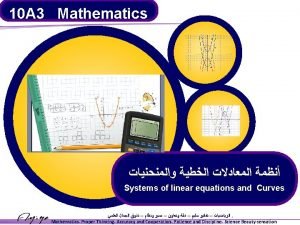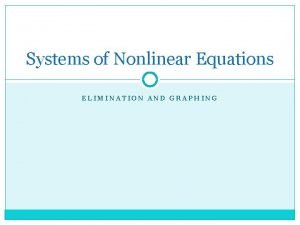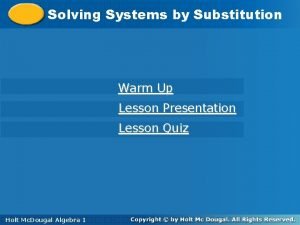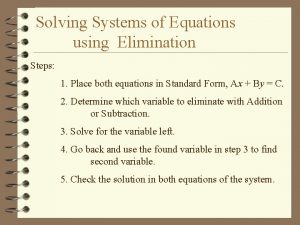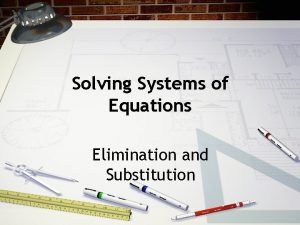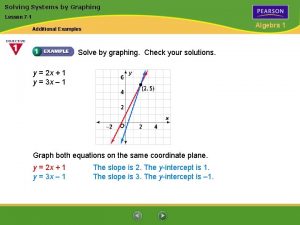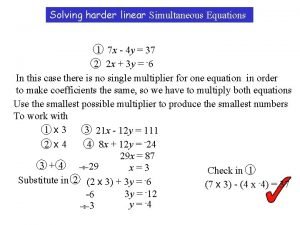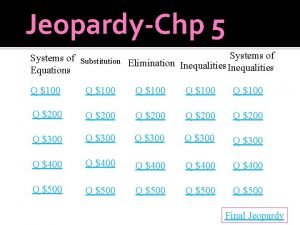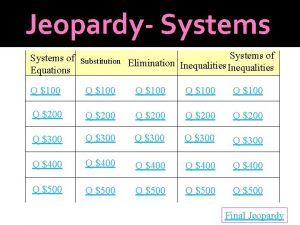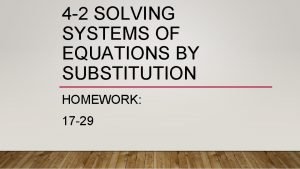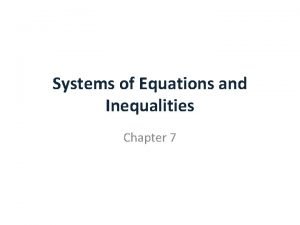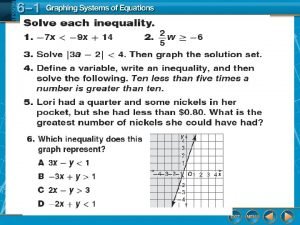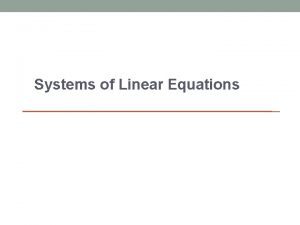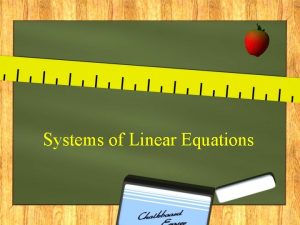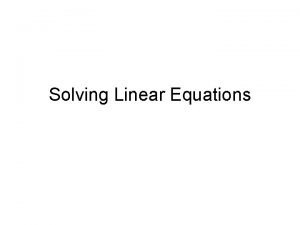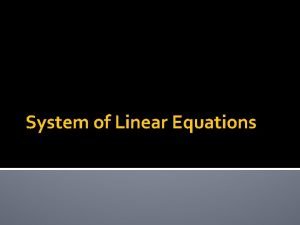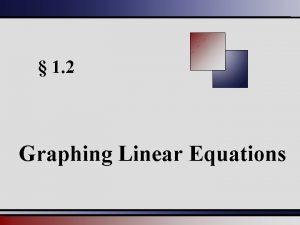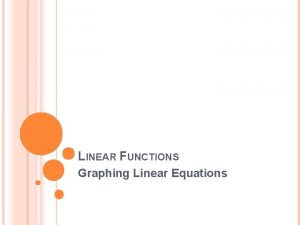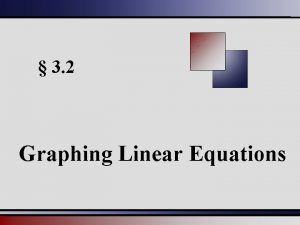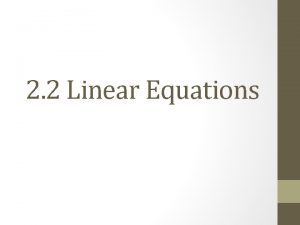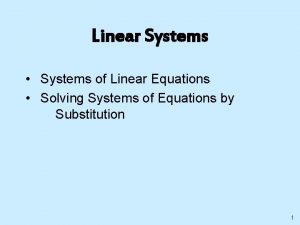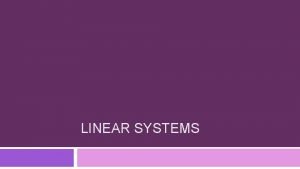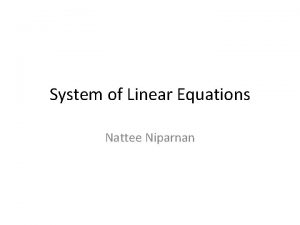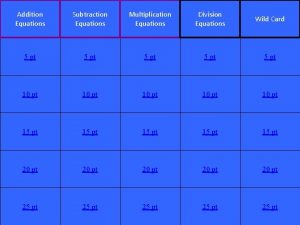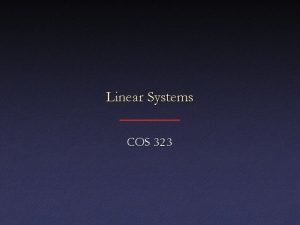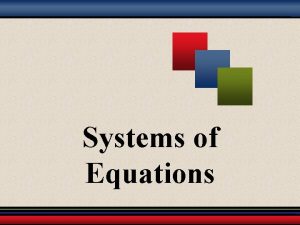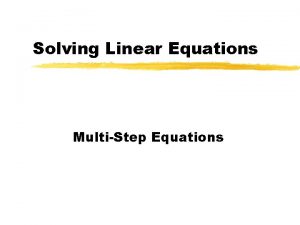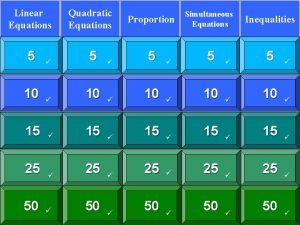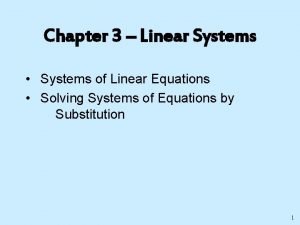Systems of Linear Equations A system of linear

































- Slides: 33

Systems of Linear Equations A system of linear equations consists of two or more linear equations. We will focus on only two equations at a time. The solution of a system of linear equations in two variables is any ordered pair that solves both of the linear equations. The solution to the system is the point that satisfies ALL of the equations. This point will be an ordered pair. When graphing, you will encounter three possibilities.

IDENTIFYING THE NUMBER OF SOLUTIONS OF A LINEAR SYSTEM y y y x x x Lines intersect Lines are parallel Lines coincide one solution no solution infinitely many solutions

Parallel Lines These lines never intersect! Since the lines never cross, there is NO SOLUTION! Parallel lines have the same slope with different y -intercepts.

Same Lines These lines are the same! Since the lines are on top of each other, there are INFINITELY MANY SOLUTIONS! Coinciding lines have the same slope and y-intercepts.

What is the solution of the system graphed below? 1. (2, -2) 2. (-2, 2) 3. No solution 4. Infinitely many solutions

Name the Solution

Solving a system of equations by graphing. Let's summarize! There are 3 steps to solving a system using a graph. Step 1: Graph both equations. Graph using slope and y – intercept or x- and y-intercepts. Be sure to use a ruler and graph paper! Step 2: Do the graphs intersect? This is the solution! LABEL the solution! Step 3: Check your solution. Substitute the x and y values into both equations to verify the point is a solution to both equations.

Solution of a System Example Determine whether the given point is a solution of the following system. point: (– 3, 1) system: x – y = – 4 and 2 x + 10 y = 4 • Plug the values into the equations. First equation: – 3 – 1 = – 4 true Second equation: 2(– 3) + 10(1) = – 6 + 10 = 4 true • Since the point (– 3, 1) produces a true statement in both equations, it is a solution.

Solving graphically Y= 2 x + 4 Y=4 x

Solving graphically Y= ⅗ x -2 Y=x - 4

Solving graphically Y= -3 x - 10 Y= 2 x

Solving graphically Y= -3 x - 10 Y= 2 x

Solving graphically Y= 3 x - 8 Y=3 x + 1

Solving graphically Y= 3 x - 8 Y=3 x + 1

Graphing using x and y intercepts 5 x + 3 y = 15

Graphing using x and y intercepts -2 x + 4 y = 16

1) Find the solution to the following system: 2 x + y = 4 x-y=2 Graph both equations. I will graph using x- and y-intercepts (plug in zeros). 2 x + y = 4 (0, 4) and (2, 0) x–y=2 (0, -2) and (2, 0) Graph the ordered pairs.

Graph the equations. 2 x 2 x + y = 4 +y =4 (0, 4) and (2, 0) x-y=2 (0, -2) and (2, 0) x Where do the lines intersect? (2, 0) – y = 2

Check your answer! To check your answer, plug the point back into both equations. 2 x + y = 4 2(2) + (0) = 4 x-y=2 (2) – (0) = 2 Nice job…let’s try another!

2) Find the solution to the following system: y = 2 x – 3 -2 x + y = 1 Graph both equations. Put both equations in slopeintercept or standard form. I’ll do slope-intercept form on this one! y = 2 x – 3 y = 2 x + 1 Graph using slope and y-intercept

Graph the equations. y = 2 x – 3 m = 2 and b = -3 y = 2 x + 1 m = 2 and b = 1 Where do the lines intersect? No solution! Notice that the slopes are the same with different y-intercepts. If you recognize this early, you don’t have to graph them!

Practice – Solving by Graphing (1, 2) y – x = 1 (0, 1) and (-1, 0) y + x = 3 (0, 3) and (3, 0) Solution is probably (1, 2) … Check it: 2 – 1 = 1 true 2 + 1 = 3 true therefore, (1, 2) is the solution

Practice – Solving by Graphing Inconsistent: no solutions y = -3 x + 5 (0, 5) and (3, -4) y = -3 x – 2 (0, -2) and (-2, 4) They look parallel: No solution Check it: m 1 = m 2 = -3 Slopes are equal therefore it’s an inconsistent system

Consistent: infinite sol’s 3 y – 2 x = 6 (0, 2) and (-3, 0) -12 y + 8 x = -24 (0, 2) and (-3, 0) (1, 2) Looks like a dependant system … Check it: divide all terms in the 2 nd equation by -4 and it becomes identical to the 1 st equation therefore, consistent, dependant system

Graph the system of equations. Determine whether the system has one solution, no solution, or infinitely many solutions. If the system has one solution, determine the solution.

The Substitution Method Solving a System of Linear Equations by the Substitution Method 1) Solve one of the equations for a variable. 2) Substitute the expression from step 1 into the other 3) 4) 5) equation. Solve the new equation. Substitute the value found in step 3 into either equation containing both variables. Check the proposed solution in the original equations.

The Substitution Method Solve the following system using the substitution method. 3 x – y = 6 and – 4 x + 2 y = – 8 Solving the first equation for y, 3 x – y = 6 –y = – 3 x + 6 y = 3 x – 6 (subtract 3 x from both sides) (multiply both sides by – 1) Substitute this value for y in the second equation. – 4 x + 2 y = – 8 – 4 x + 2(3 x – 6) = – 8 – 4 x + 6 x – 12 = – 8 2 x = 4 x=2 (replace y with result from first equation) (use the distributive property) (simplify the left side) (add 12 to both sides) (divide both sides by 2) Continued.

The Substitution Method Substitute x = 2 into the first equation solved for y. y = 3 x – 6 = 3(2) – 6 = 6 – 6 = 0 Our computations have produced the point (2, 0). Check the point in the original equations. First equation, 3 x – y = 6 3(2) – 0 = 6 true Second equation, – 4 x + 2 y = – 8 – 4(2) + 2(0) = – 8 true The solution of the system is (2, 0).

The Elimination Method Solving a System of Linear Equations by the Addition or Elimination Method 1) Rewrite each equation in standard form, eliminating 2) 3) 4) 5) 6) fraction coefficients. If necessary, multiply one or both equations by a number so that the coefficients of a chosen variable are opposites. Add the equations. Find the value of one variable by solving equation from step 3. Find the value of the second variable by substituting the value found in step 4 into either original equation. Check the proposed solution in the original equations.

The Elimination Method Solve the following system of equations using the elimination method. 6 x – 3 y = – 3 and 4 x + 5 y = – 9 Multiply both sides of the first equation by 5 and the second equation by 3. First equation, 5(6 x – 3 y) = 5(– 3) 30 x – 15 y = – 15 (use the distributive property) Second equation, 3(4 x + 5 y) = 3(– 9) 12 x + 15 y = – 27 (use the distributive property) Continued.

The Elimination Method Combine the two resulting equations (eliminating the variable y). 30 x – 15 y = – 15 12 x + 15 y = – 27 42 x = – 42 x = – 1 (divide both sides by 42) Continued.

The Elimination Method Substitute the value for x into one of the original equations. 6 x – 3 y = – 3 6(– 1) – 3 y = – 3 (replace the x value in the first equation) – 6 – 3 y = – 3 (simplify the left side) – 3 y = – 3 + 6 = 3 (add 6 to both sides and simplify) y = – 1 (divide both sides by – 3) Our computations have produced the point (– 1, – 1). Continued.

The Elimination Method Check the point in the original equations. First equation, 6 x – 3 y = – 3 6(– 1) – 3(– 1) = – 3 Second equation, 4 x + 5 y = – 9 4(– 1) + 5(– 1) = – 9 true The solution of the system is (– 1, – 1).
 Systems of equations word problems
Systems of equations word problems Method of elimination
Method of elimination System of equations calculator
System of equations calculator Systems of linear equations real world applications
Systems of linear equations real world applications Homogeneous system of linear equations examples
Homogeneous system of linear equations examples Infinitely many solutions formula
Infinitely many solutions formula Solving systems of linear and quadratic equations
Solving systems of linear and quadratic equations Graphical method simultaneous equations
Graphical method simultaneous equations Difference between linear and nonlinear
Difference between linear and nonlinear Sistem persamaan linear metode numerik
Sistem persamaan linear metode numerik System of linear equations with two variables
System of linear equations with two variables Solution set of linear equation
Solution set of linear equation System of linear equations
System of linear equations Graph inconsistent
Graph inconsistent Triangular form system of equations
Triangular form system of equations حل معادلة x2+(y-3√x2)2=1
حل معادلة x2+(y-3√x2)2=1 9-3 practice polar and rectangular forms of equations
9-3 practice polar and rectangular forms of equations Translate word equations to chemical equations
Translate word equations to chemical equations Graphing systems of nonlinear equations
Graphing systems of nonlinear equations Solving systems of equations by substitution activity
Solving systems of equations by substitution activity Steps for solving systems of equations by elimination
Steps for solving systems of equations by elimination Substitution and elimination examples
Substitution and elimination examples Lesson 7 solve systems of equations by graphing
Lesson 7 solve systems of equations by graphing Simultaneous equations non linear
Simultaneous equations non linear Solving word problems using systems of equations
Solving word problems using systems of equations Systems of equations card match answer key
Systems of equations card match answer key Carlos graphed the system of equations
Carlos graphed the system of equations Solving equations and inequalities jeopardy
Solving equations and inequalities jeopardy Solving inequalities jeopardy
Solving inequalities jeopardy Solving systems by substitution word problems
Solving systems by substitution word problems Solving inequalities
Solving inequalities Chapter 7 systems of equations and inequalities answers
Chapter 7 systems of equations and inequalities answers 7-1 graphing systems of equations answers
7-1 graphing systems of equations answers 6-1 graphing systems of equations answers
6-1 graphing systems of equations answers
